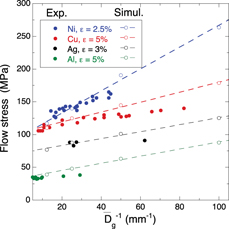Crossref Citations
This article has been cited by the following publications. This list is generated based on data provided by
Crossref.
Bieler, T.R.
Alizadeh, R.
Peña-Ortega, M.
and
Llorca, J.
2019.
An analysis of (the lack of) slip transfer between near-cube oriented grains in pure Al.
International Journal of Plasticity,
Vol. 118,
Issue. ,
p.
269.
Esteban-Manzanares, G.
Bellón, B.
Martínez, E.
Papadimitriou, I.
and
LLorca, J.
2019.
Strengthening of Al–Cu alloys by Guinier–Preston zones: Predictions from atomistic simulations.
Journal of the Mechanics and Physics of Solids,
Vol. 132,
Issue. ,
p.
103675.
Shveykin, Alexey
Trusov, Peter
and
Sharifullina, Elvira
2020.
Statistical Crystal Plasticity Model Advanced for Grain Boundary Sliding Description.
Crystals,
Vol. 10,
Issue. 9,
p.
822.
Alizadeh, R.
Peña-Ortega, M.
Bieler, T.R.
and
LLorca, J.
2020.
A criterion for slip transfer at grain boundaries in Al.
Scripta Materialia,
Vol. 178,
Issue. ,
p.
408.
Fomin, Eugeniy V.
and
Mayer, Alexander E.
2020.
Slip of low-angle tilt grain boundary (110) in FCC metals at perpendicular shear.
International Journal of Plasticity,
Vol. 134,
Issue. ,
p.
102843.
Bellón, B.
Haouala, S.
and
LLorca, J.
2020.
An analysis of the influence of the precipitate type on the mechanical behavior of Al - Cu alloys by means of micropillar compression tests.
Acta Materialia,
Vol. 194,
Issue. ,
p.
207.
Haouala, S.
Lucarini, S.
LLorca, J.
and
Segurado, J.
2020.
Simulation of the Hall-Petch effect in FCC polycrystals by means of strain gradient crystal plasticity and FFT homogenization.
Journal of the Mechanics and Physics of Solids,
Vol. 134,
Issue. ,
p.
103755.
Haouala, S.
Alizadeh, R.
Bieler, T.R.
Segurado, J.
and
LLorca, J.
2020.
Effect of slip transmission at grain boundaries in Al bicrystals.
International Journal of Plasticity,
Vol. 126,
Issue. ,
p.
102600.
Motaman, S. Amir H.
and
Haase, Christian
2021.
The microstructural effects on the mechanical response of polycrystals: A comparative experimental-numerical study on conventionally and additively manufactured metallic materials.
International Journal of Plasticity,
Vol. 140,
Issue. ,
p.
102941.
Gélébart, Lionel
2021.
Grain size effects and weakest link theory in 3D crystal plasticity simulations of polycrystals.
Comptes Rendus. Physique,
Vol. 22,
Issue. S3,
p.
313.
Nguyen, Khanh
Zhang, Meijuan
Amores, Víctor Jesús
Sanz, Miguel A.
and
Montáns, Francisco J.
2021.
Computational Modeling of Dislocation Slip Mechanisms in Crystal Plasticity: A Short Review.
Crystals,
Vol. 11,
Issue. 1,
p.
42.
Li, Maojun
Wang, Zhuoling
and
Chen, Xu
2021.
Effects of Initial Equiaxed Crystal Ratio in As-Cast Slab on Texture Evolution and Formability of Ferritic Stainless Steel.
Journal of Materials Engineering and Performance,
Vol. 30,
Issue. 1,
p.
379.
Chen, Ze
Wang, Chengcheng
Tang, Chao
Lek, Yung Zhen
Kandukuri, Sastry Yagnanna
Du, Hejun
Gao, Huajian
and
Zhou, Kun
2022.
Microstructure and mechanical properties of a Monel K-500 alloy fabricated by directed energy deposition.
Materials Science and Engineering: A,
Vol. 857,
Issue. ,
p.
144113.
Yousefi Mehr, Vahid
and
Toroghinejad, Mohammad Reza
2022.
On the texture evolution of aluminum-based composites manufactured by ARB process: a review.
Journal of Materials Research and Technology,
Vol. 21,
Issue. ,
p.
1095.
Andrews, Miriam
Polcar, Tomas
Sofaer, Joanna
and
Pike, Alistair W. G.
2022.
The mechanised testing and sequential wear‐analysis of replica Bronze Age palstave blades.
Archaeometry,
Vol. 64,
Issue. 1,
p.
177.
Nieto-Valeiras, E.
Haouala, S.
and
LLorca, J.
2022.
On the effect of slip transfer at grain boundaries on the strength of FCC polycrystals.
European Journal of Mechanics - A/Solids,
Vol. 91,
Issue. ,
p.
104427.
Wan, Wei
and
Tang, Changxin
2023.
Structures and energies of computed silicon (001) small angle mixed grain boundaries as a function of three macroscopic characters.
Acta Materialia,
Vol. 261,
Issue. ,
p.
119353.
Fomin, E.V.
2023.
STUDY OF THE TEMPERATURE DEPENDENCE OF THE SYMMETRICAL GRAIN BOUNDARY ENERGIES ON THE PLANE (110) IN ALUMINUM.
Челябинский физико-математический журнал,
Vol. 8,
Issue. 3,
p.
421.
Zhang, Xu
Zhao, Jianfeng
Kang, Guozheng
and
Zaiser, Michael
2023.
Geometrically necessary dislocations and related kinematic hardening in gradient grained materials: A nonlocal crystal plasticity study.
International Journal of Plasticity,
Vol. 163,
Issue. ,
p.
103553.
Wan, Wei
Tang, Changxin
and
Homer, Eric R.
2024.
Can we predict mixed grain boundaries from their tilt and twist components?.
Acta Materialia,
Vol. 279,
Issue. ,
p.
120293.



